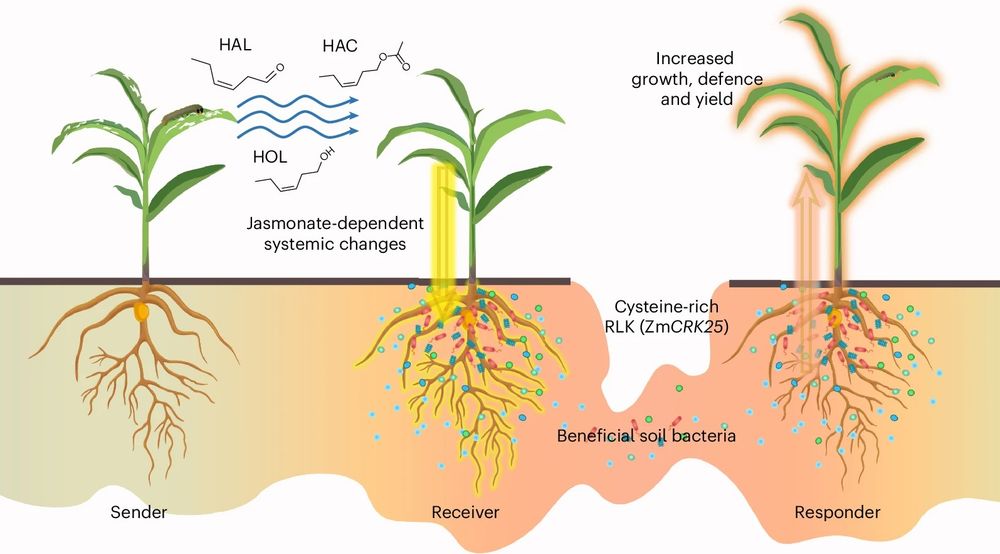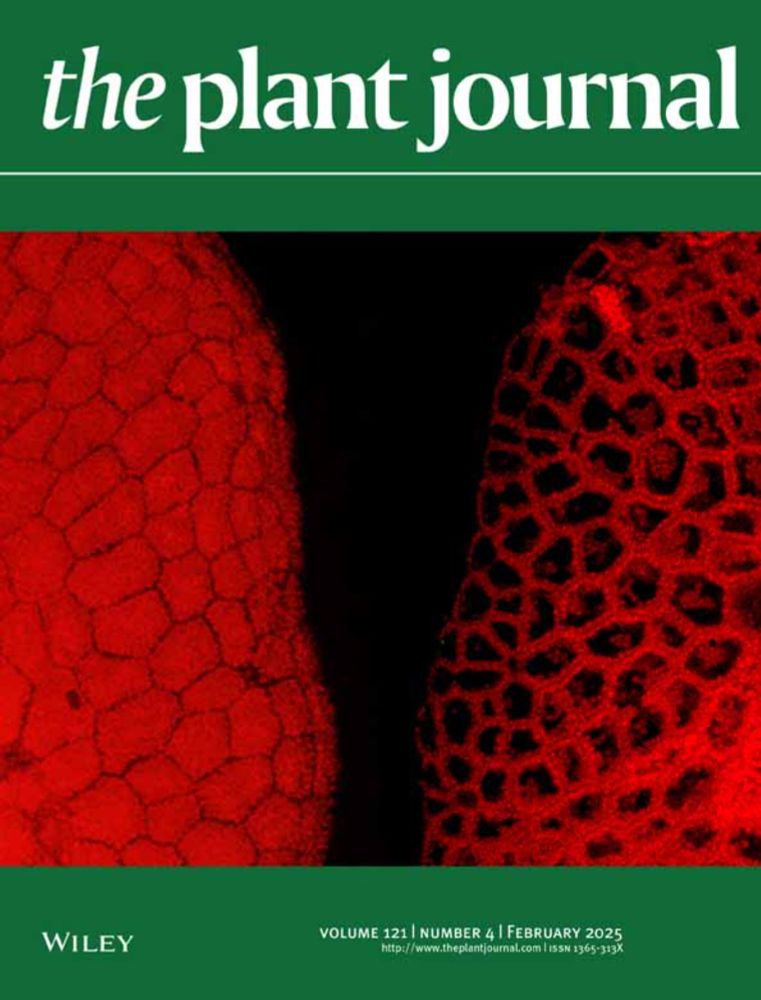
Charles Melnyk
@charlesmelnyk.bsky.social
Plant biologist studying grafting, tissue regeneration and parasitic plants at the Swedish University of Agricultural Sciences: www.melnyklab.com
Reposted by Charles Melnyk
Plant Science Research Weekly: July 18, 2025 plantae.org/plant-scienc... (3/3) The hidden power of water in plant regeneration; ; Unusual cell death pathway in maize endosperm; Herbivore bites promote plant growth in the succeeding year. @matthiaserb.bsky.social @charlesmelnyk.bsky.social

July 18, 2025 at 7:05 AM
Plant Science Research Weekly: July 18, 2025 plantae.org/plant-scienc... (3/3) The hidden power of water in plant regeneration; ; Unusual cell death pathway in maize endosperm; Herbivore bites promote plant growth in the succeeding year. @matthiaserb.bsky.social @charlesmelnyk.bsky.social
Interesting! Probably a piece of the Che was left on and grew back. Much less likely but maybe something chimeric or a hybrid? Chimeras have been seen in orange before (the Bizzarria). Have a look at these reviews:
onlinelibrary.wiley.com/doi/10.1111/...
www.sciencedirect.com/science/arti...
onlinelibrary.wiley.com/doi/10.1111/...
www.sciencedirect.com/science/arti...

Modern and historical uses of plant grafting to engineer development, stress tolerance, chimeras, and hybrids
Plant grafting has been practiced for millennia and recent developments have resulted in new species, new techniques and new applications appearing. Here, we review these advances focusing on develop...
onlinelibrary.wiley.com
July 12, 2025 at 1:07 PM
Interesting! Probably a piece of the Che was left on and grew back. Much less likely but maybe something chimeric or a hybrid? Chimeras have been seen in orange before (the Bizzarria). Have a look at these reviews:
onlinelibrary.wiley.com/doi/10.1111/...
www.sciencedirect.com/science/arti...
onlinelibrary.wiley.com/doi/10.1111/...
www.sciencedirect.com/science/arti...
9/n. A collaborative effort with Abdul Kareem, Anna van Wüllen, Ai Zhang, Gabriel Walckiers and Ellen Fasth. A huge thanks to our funders @erc.europa.eu, @kawresearch.bsky.social and @vetenskapsradet.bsky.social for supporting and enabling this research!
July 8, 2025 at 11:54 AM
9/n. A collaborative effort with Abdul Kareem, Anna van Wüllen, Ai Zhang, Gabriel Walckiers and Ellen Fasth. A huge thanks to our funders @erc.europa.eu, @kawresearch.bsky.social and @vetenskapsradet.bsky.social for supporting and enabling this research!
8/n. An interesting outcome of this work is that high water availability is really good at regenerating roots and promoting in vitro regeneration (pubmed.ncbi.nlm.nih.gov/20230752). If you want to improve your in vitro regeneration rates, try using lower agar concentrations in your media.
July 8, 2025 at 11:52 AM
8/n. An interesting outcome of this work is that high water availability is really good at regenerating roots and promoting in vitro regeneration (pubmed.ncbi.nlm.nih.gov/20230752). If you want to improve your in vitro regeneration rates, try using lower agar concentrations in your media.
7/n. What’s the relevance of this? We used air layering (www.rhs.org.uk/propagation/...) in tomato and found wet soil induced roots but dry soil induced callus. Thus, when wounds are in contact with water, roots form (think of plant propagation!) whereas under dry conditions, callus seals the wound

Air layering of plants / RHS
Air layering is a method of propagating new trees and shrubs from stems still attached to the parent plant. The stem is wrapped with damp moss to encourage roots to form.
www.rhs.org.uk
July 8, 2025 at 11:50 AM
7/n. What’s the relevance of this? We used air layering (www.rhs.org.uk/propagation/...) in tomato and found wet soil induced roots but dry soil induced callus. Thus, when wounds are in contact with water, roots form (think of plant propagation!) whereas under dry conditions, callus seals the wound
6/n. High water promoted ethylene and jasmonic acid responses, and these hormones could shift the auxin maxima away from the wound likely via PIN transporters. Thus, high water induced ethylene and jasmonic acid to change PIN localisation and move auxin maxima away from the wound to promote rooting
July 8, 2025 at 11:47 AM
6/n. High water promoted ethylene and jasmonic acid responses, and these hormones could shift the auxin maxima away from the wound likely via PIN transporters. Thus, high water induced ethylene and jasmonic acid to change PIN localisation and move auxin maxima away from the wound to promote rooting
5/n. We found that water moved the auxin response maxima at the wound either away (distal) or towards (proximal) the cut. Distal response was associated with root formation while proximal response with callus formation. So the location of auxin response could induce different regeneration fates.
July 8, 2025 at 11:43 AM
5/n. We found that water moved the auxin response maxima at the wound either away (distal) or towards (proximal) the cut. Distal response was associated with root formation while proximal response with callus formation. So the location of auxin response could induce different regeneration fates.
4/n. What decides whether a wound forms roots or callus? Water! By changing water availability, we could transition between these two fates. High water promoted roots near the wound, whereas low water promoted callus formation at the wound. These processes seemed to antagonise one another
July 8, 2025 at 11:39 AM
4/n. What decides whether a wound forms roots or callus? Water! By changing water availability, we could transition between these two fates. High water promoted roots near the wound, whereas low water promoted callus formation at the wound. These processes seemed to antagonise one another
3/n. Roots formed at wounds follow a lateral root formation pathway (pubmed.ncbi.nlm.nih.gov/24642937) but what about callus from wounds? We used reporters and mutants to find that callus follows a procambium pathway suggesting that different regeneration fates used different molecular pathways.
July 8, 2025 at 11:37 AM
3/n. Roots formed at wounds follow a lateral root formation pathway (pubmed.ncbi.nlm.nih.gov/24642937) but what about callus from wounds? We used reporters and mutants to find that callus follows a procambium pathway suggesting that different regeneration fates used different molecular pathways.
2/n. Regeneration is fundamental for plant survival but how do plants know what to regenerate? We sought to address this question using cut Arabidopsis petioles that can either form roots, callus or both at the site of wounding
July 8, 2025 at 11:35 AM
2/n. Regeneration is fundamental for plant survival but how do plants know what to regenerate? We sought to address this question using cut Arabidopsis petioles that can either form roots, callus or both at the site of wounding
Thanks Thomas and Hannes for highlighting our work. Great commentary and very well written!
March 21, 2025 at 11:36 AM
Thanks Thomas and Hannes for highlighting our work. Great commentary and very well written!

